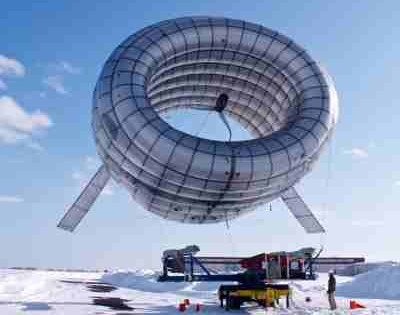Towerless wind turbine
Altaeros' BAT (Buoyant Airborne Turbine) prototype will be tested soon in Alaska. Remote settlements or communities far from the power grid pay dearly for electricity.
Share
Read Next

Altaeros' BAT (Buoyant Airborne Turbine) prototype will be tested soon in Alaska
Remote settlements or communities far from the power grid pay dearly for electricity. In Alaska, for example, the cost of energy from diesel generators reportedly can reach $1 per kilowatt-hour (compared to $0.10/kW-hr or less for coal-, natural gas- or wind-sourced energy in the lower 48 states of the U.S.). Altaeros Energies (Boston, Mass.) aims to change the situation. The new wind energy startup, a spin-off from the Massachusetts Institute of Technology (MIT), has developed the Buoyant Airborne Turbine (BAT), a lighter-than-air wind turbine that can harvest more consistent winds at higher altitudes because its height is not limited by the need for a tower. To demonstrate that capability, a $1.3 million (USD), 18-month project, partially financed by the Alaska Energy Authority’s Emerging Energy Technology Fund, is set to break a world record at a site south of Fairbanks for the highest wind turbine ever deployed, at 1,000 ft/308m.
Adapted from aerostats (blimps) that have long lifted heavy communications and weather equipment skyward, the BAT consists of a helium-filled inflatable shell, surrounding a turbine. High-strength tethers do double-duty, holding the BAT steady and transporting electricity to microgrid power on the ground. Altaeros cofounder and CEO Ben Glass says the Alaskan BAT prototype uses a small Skystream turbine, supplied by XZERES Wind Corp. (Wilsonville, Ore.), with carbon fiber composite blades made by the University of Maine’s Advanced Structures and Composites Center (ASCC, Orono, Maine). Altaeros replaced the turbine’s aluminum nacelle with a sandwich construction of three-ply carbon fiber skins over an aramid honeycomb core, says Glass, to save additional weight. The prototype nacelle was made in-house.
“BAT is a low-cost power solution … that can power more than a dozen homes,” explains Glass. “The BAT can be transported and set up without the need for large cranes, towers or underground foundations that have hampered past wind projects.” Altaeros estimates the expenditures for remote power and microgrids is $17 billion per year.Target customers include remote and island communities; oil & gas, mining, agriculture, and telecommunications firms; disaster relief organizations; and military bases. In 2013, Altaeros successfully tested a BAT prototype in 45-mph/72-kmh winds and at a height of 500 ft/152.4m at its test site in Maine, and is currently working on rotor and nacelle designs for commercial full-scale BAT deployments. Glass says the first commercial product will be about 30kw, and future scale-ups could reach 100 to 200kW. The commercial units will be slightly larger in size than the Alaskan proof-of-concept.
Related Content
-
Polar Technology develops innovative solutions for hydrogen storage
Conformable “Hydrogen in a Box” prototype for compressed gas storage has been tested to 350 and 700 bar, liquid hydrogen storage is being evaluated.
-
Collins Aerospace to lead COCOLIH2T project
Project for thermoplastic composite liquid hydrogen tanks aims for two demonstrators and TRL 4 by 2025.
-
Achieving composites innovation through collaboration
Stephen Heinz, vice president of R&I for Syensqo delivered an inspirational keynote at SAMPE 2024, highlighting the significant role of composite materials in emerging technologies and encouraging broader collaboration within the manufacturing community.












